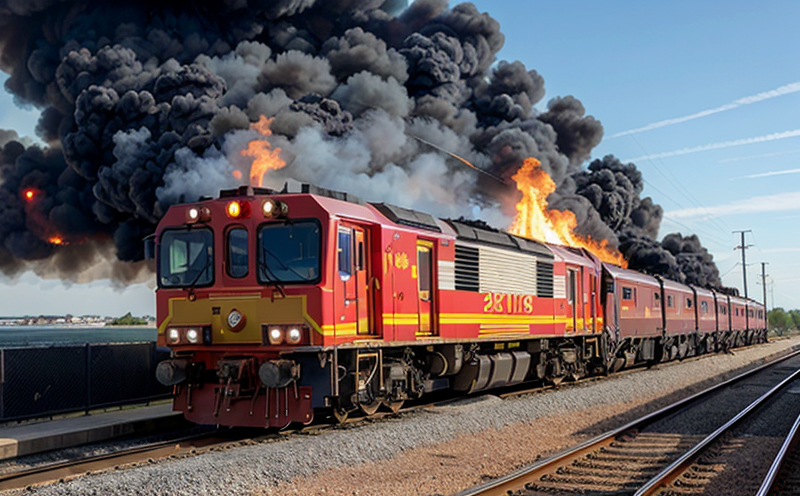Laboratory Documentation of Railway Fire Tests
The importance of railway fire safety testing cannot be overstated. Railways are not only critical to modern transportation systems but also pose unique challenges when it comes to fire safety. The materials used in railway vehicles, the design of compartments, and the operational environment all contribute to the complexity of ensuring that these structures can withstand the rigors of a fire scenario.
At our laboratory, we provide comprehensive documentation services for railway fire tests conducted according to international standards such as ISO 8613-2. This involves conducting rigorous testing on various components and materials used in railway vehicles including upholstery, seating, partitions, and other interior fittings. The goal is to ensure that these materials meet strict flammability limits which are designed to minimize the risk of fire spreading.
The process begins with receiving samples from our clients or directly from the manufacturing site. Our experienced technical team then prepares the specimens for testing by ensuring they accurately represent the intended end use. This includes cutting pieces according to specified dimensions and preparing them for exposure to simulated flame sources in our state-of-the-art laboratory facilities.
Once prepared, we conduct a series of tests which may include vertical burn tests (ASTM E619), thermogravimetric analysis (TGA) to measure the rate at which materials lose mass when heated, and other relevant assessments. These tests are conducted under controlled conditions that replicate real-world scenarios as closely as possible.
After completing each test run, our dedicated reporting team compiles all data points into detailed reports that summarize findings from every aspect of the testing process. This includes visual observations during combustion events, measurements of smoke production and heat release rates, and any other relevant metrics captured by our instrumentation.
The resulting documentation serves multiple purposes beyond mere compliance with regulatory requirements; it provides valuable insights into material performance which can inform future design improvements or modifications aimed at enhancing overall safety. For instance, if certain materials do not pass muster according to specified criteria, this information becomes crucial input for subsequent iterations of product development.
In summary, our laboratory documentation service offers a robust solution for railway fire testing that combines cutting-edge technology with meticulous attention to detail. By providing accurate and comprehensive reports based on internationally recognized standards like ISO 8613-2, we help ensure the highest level of safety in rail transport systems.
Applied Standards
- ISO 8613-2: This standard specifies procedures for determining the flammability characteristics of materials used in railway vehicles. It covers both bench-scale tests and full-scale trials.
- ASTM E619: Known as the Test Method for Determining the Ignition Strength of Plastics, this American Society for Testing Materials standard provides guidelines for assessing how easily a material will ignite under specific conditions.
- TGA (Thermogravimetric Analysis): This technique measures changes in mass during heating or cooling processes. In our context, it helps quantify the extent of thermolysis—breakdown due to heat—which is important for understanding how materials behave when exposed to flames.
Scope and Methodology
The scope of our laboratory documentation service encompasses various stages from sample receipt through final report generation. From the moment we receive raw samples, our experienced technicians meticulously prepare them for testing according to predefined protocols laid out by applicable standards.
In terms of methodology, each test is conducted under closely monitored conditions ensuring consistency across multiple trials if necessary. Our highly trained personnel use advanced instrumentation such as photometers to measure visible light emitted during combustion processes and calorimeters to determine heat release rates accurately.
Data collected throughout the testing period forms the basis for our detailed reports which include not only numerical values but also qualitative observations regarding behavior of materials under fire exposure. These reports serve multiple stakeholders including manufacturers, regulatory bodies, and insurance companies seeking assurance about product safety.
Use Cases and Application Examples
- New Product Development: When developing new types of upholstery or seating solutions, manufacturers rely on our testing services to ensure compliance with stringent flammability regulations.
- Material Modifications: After initial tests reveal areas for improvement, we work closely with clients to refine their materials until they achieve optimal safety ratings.
- Compliance Audits: Regular testing helps railway operators maintain compliance with international standards ensuring continued safe operation of their fleets.





